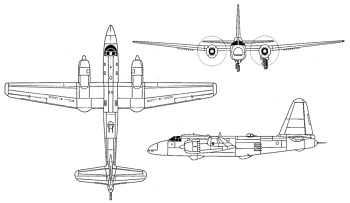



Lockheed's long line of successful land-based maritime patrol aircraft continued post-war with the remarkable P-2 Neptune which served for over three decades with the US Navy and even more with various other countries which adopted it. The attractive P-2 was designed as a replacement for the Ventura and Harpoon aircraft which had been used during World War II and in contrast to its predecessors, was built from the start to perform in its maritime role as an attractive two-engine mid-wing design which also included a tricycle undercarriage and radar (later versions also featured two auxiliary turbojets). P-2s not only were used for patrol and ASW duties: proof of their versatility was the conversion into early warning, anti-shipping, interdiction, airborne relay, drone launching, and electronic reconnaissance platforms. With the US they saw considerable use over Korea as well as Vietnam and was exported to 10 other nations including Argentina (which used it during the Falklands War), Australia, Brazil, Canada, Chile, France, the Netherlands, Portugal, the UK, and Japan which license produced an advanced version by Kawasaki. US P-2s were eventually phased out in favor of the P-3 Orion and were fully retired in 1978.
Begun as the Lockheed Model 26, the XP2V-1 had its maiden flight as early as 17 May 1945 and entered service almost exactly two years later as the P2V-1. Its follow-ups were the P2V-2 with a solid nose armed with cannons, the P2V-3 with provision for underwing rockets, the P2V-4 (redesignated P-2D after 1962) with new engines, wingtip fuel tanks, and sonobuoys as well as an improved radar. A significant upgrade to the Neptune began with the P2V-5 (P-2E) which was the first to be built in large numbers. It had additional fuel capacity, extra sensors and equipment, and the inclusion of auxiliary turbojet engines in what would become the P2V-5F (P-2F). Later, the P2V-6 for minelaying and torpedo attack duties as well as reconnaissance and was also known as the P2V-6F (P-2G) with the extra turbojets. The final patrol version for the USN was the P2V-7 (P-2H) with a new bulged canopy and a MAD boom. Other versions built in limited numbers were the P2V-3W early warning variant, the AP-2E for Sigint/Elint duties, the AP-2H gunship conversion, and the RB-69A for aerial reconnaissance. Foreign versions included the Neptune MR.1 for the UK, the CP-122 for Canada, and the Japanese-built PV2-Kai (P-2J) with numerous improvements over US versions and with subvariants including the EP-2J Elint platform and the UP-2J for target towing and ECM training.
Preceded by:
NoneSucceeded by:
None |  |  | |
| Design | P2V-2 | P-2H | P-2J |
| Name | Neptune | Neptune | Neptune |
| Type | Maritime Patrol | Maritime Patrol | Maritime Patrol |
| Year | 1947 | 1954 | 1969 |
| Crew | 9-10 | 7-9 | 10-12 |
| Dimensions | |||
| Length | 77 ft 10 in | 91 ft 8½ in | 95 ft 10 in |
| Height | 28 ft 1 in | 29 ft 4 in | 29 ft 3 in |
| Wing Span | 100 ft 0½ in | 103 ft 10 in | 101 ft 4 in |
| Wing Area | n/a | n/a | n/a |
| Weight | |||
| Empty | 33,960 lbs | 43,010 lbs | 42,500 lbs |
| Maximum | 63,081 lbs | 80,001 lbs | 75,001 lbs |
| Wing Loading | 63.1 lb/ft² | 80.0 lb/ft² | 75.0 lb/ft² |
| Performance | |||
| Speed | 320 mph | 364 mph | 403 mph |
| Ceiling | 26,000 ft | 22,400 ft | 30,000 ft |
| Range | 3,980 mi | 4,350 mi | 2,764 mi |
| Powerplant | |||
| Engine | 2 x R-3350-24W Wright 2,800 hp | 2 x R-3350-32W Wright 3,700 hp | 2 x T64-IHI-10 Ishikawajima 2,850 hp |
| Thrust/Weight | 0.33 | 0.34 | 0.27 |
| Sensors | |||
| Radar | - | AN/APS-20 | AN/APS-80 |
| Armament | |||
| Guns | 4 x 20-mm 2 x .50-in | - | - |
| Payload | 8,000 lbs | 8,000 lbs | 8,000 lbs |
| Production | |||
| Built | 81 | 311 | 82 |
| Total | 1,181 |